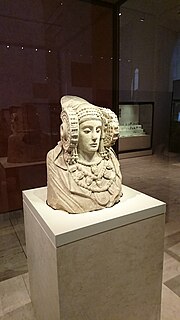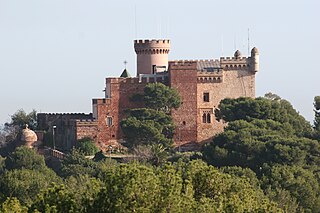 W
WThe Iberians were a set of people that Greek and Roman sources identified with that name in the eastern and southern coasts of the Iberian peninsula, at least from the 6th century BC. The Roman sources also use the term Hispani to refer to the Iberians.
 W
WAudax, Ditalcus and Minurus were Turdetanian warriors who participated in the Lusitanian War. They were the supposed betrayers and assassins of the Lusitanian leader Viriathus.
 W
WThe Ca n'Oliver Iberian settlement is a very large Iberian settlement found in the Collserola mountain range, in the territory formerly known as Laietania, in present-day Cerdanyola del Vallès. It is an archaeological site that was inhabited between the 6th century and 50 BC and, later on, in the Middle Ages.
 W
WCastell de la Fosca or Punta del Castell is an ancient Iberian settlement or oppidum sited on a rocky promontory at the north end of the beach called Platja de Castell, about 2 kilometres (1.2 mi) ENE of Palamós, on the Costa Brava.
 W
WCastelldefels Castle is a frontier fortress in the town of Castelldefels, near Barcelona in Spain, that was built to defend the frontier of the Carolingian Empire against neighbouring Muslim territories, particularly the Caliphate of Córdoba. The fortress was first recorded in the 10th century, as was the former parish church of St. Mary, contained within its outer wall.
 W
WThe Cerdanyola Museum is a museum in Cerdanyola del Vallès, Vallès Occidental, Catalonia, Spain. It is guided by the belief that the museum is the territory itself and comprises a group of spaces spread throughout the area. The museum’s objective is to offer a didactic approach to the evolution of the population of this area of El Vallès, following the thread of its history from prehistory to the present day. The Museum is part of the Barcelona Provincial Council Local Museum Network.
 W
WCerro de los Santos is an Iberian religious sanctuary built in the 4th century BCE, during the Iberian period, with evidence of continued use into the Roman period. The site lies in southeastern Spain near an ancient road. Little remains of the original structures at the site. Nineteenth century excavations documented some features of a temple but only an outline now remains. The site is known for its many votive sculptures, numbering about 300. Most of the sculptures depict women including the most notable find, the Dama del Cerro de los Santos. In addition to the women, statues of men, possibly dating from a later period, and a few statues of animals have also been found.
 W
WEl Camp de les Lloses was a Roman settlement located in the area around present-day Tona (Osona) and founded between the 2nd and 1st centuries BC.
 W
WIndibilis and Mandonius were chieftains of the Ilergetes, an ancient Iberian people based in the Iberian Peninsula. Polybius speaks of the brothers as the most influential and powerful of the Iberian chieftains in that time period. Livy calls one of the chieftains of the Ilergetes "Indibilis", while Polybius gives "Andobales" for the same person. They agree that his brother chieftain was Mandonius.
 W
WThe Mausoleum of Pozo Moro is a Mausoleum of the Iberians from the end of the 6th century BC, which was discovered in 1970 in excavations made in the Province of Albacete.
 W
WSagunto Castle is a fortress overlooking the town of Sagunto, near Valencia in Spain. The site's history extends back over two thousand years and includes Iberian, Roman and medieval remains. During the Islamic period, the castle was known as Murbĩtar and Morvedre. The castle was declared a National Monument in 1931.